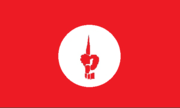Bangladesh Forces
| Mukti Bahini | |
|---|---|
|
মুক্তিবাহিনী (Freedom Fighters) Participant in Bangladesh Liberation War |
|
 
The de facto symbols of the Mukti Bahini: Emblem (top) and flag (bottom).
|
|
| Active | March – December 1971 |
| Ideology |
Bengali nationalism Resistance to the 1971 Bangladesh genocide |
| Groups |
Bangladesh Army ∟ Gono Bahini ∟ Mujib Bahini ∟ Kader Bahini ∟ Hemayet Bahini ∟ Afsar Bahini Crack Platoon |
| Leaders |
M. A. G. Osmani, Commander-in-Chief M. A. Rab, Chief of Staff A K Khandker, Deputy Chief of Staff |
| Area of operations | East Pakistan |
| Strength | 150,000 |
| Part of | Provisional Government of Bangladesh |
| Allies |
|
| Opponents |
|
| Battles and wars | Battle of Gazipur, Battle of Goalhati, Battle of Garibpur, Battle of Dhalai, Battle of Rangamati, Battle of Kushtia, Battle of Daruin, Operation Barisal, Operation Jackpot |
Bangladesh Army
∟ K Force
∟ S Force
∟ Z Force
Bangladesh Navy
Bangladesh Air Force
Bangladesh Rifles
Bangladesh Ansar
Bangladesh Police
The Mukti Bahini (Bengali: মুক্তি বাহিনী translates as Freedom Fighters, or Liberation Forces; also known as the Bangladesh Forces) is a popular Bengali term which refers to the guerrilla resistance movement formed by the Bangladeshi military, paramilitary and civilians during the War of Liberation that transformed East Pakistan into Bangladesh in 1971. An earlier name Mukti Fauj was also used.
On 25 March 1971 Sheikh Mujibur Rahman issued a call to the people of East Pakistan to prepare themselves for an all-out struggle. Later that evening resistance demonstrations began, and the military began full-scale retaliation with Operation Searchlight, which continued through May 1971.
A formal military leadership of the resistance was created in April 1971 under the Provisional Government of Bangladesh. The military council was headed by General M. A. G. Osmani and eleven sector commanders. The Bangladesh Armed Forces were established on 4 April 1971. In addition to regular units, such as the East Bengal Regiment and the East Pakistan Rifles, the Mukti Bahini also consisted of the civilian Gonobahini (People's Force). The most prominent divisions of the Mukti Bahini were the Z Force led by Major Ziaur Rahman, the K Force led by Major Khaled Mosharraf and the S Force led by Major K M Shafiullah. Awami League student leaders formed militia units, including the Mujib Bahini, the Kader Bahini and Hemayet Bahini. The Communist Party of Bangladesh, led by Comrade Moni Singh, and activists from the National Awami Party also operated several guerrilla battalions.
...
Wikipedia
